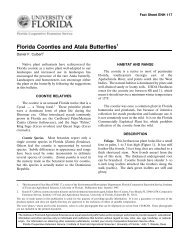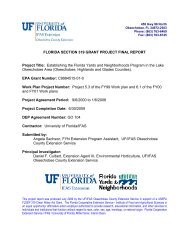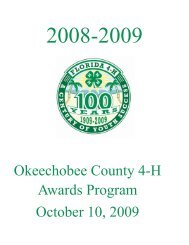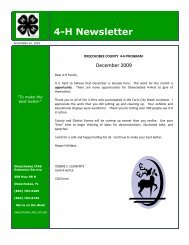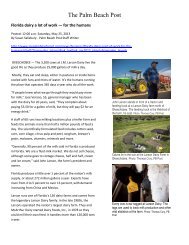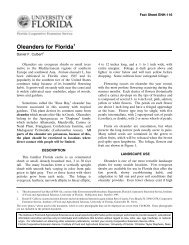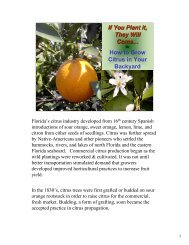Important Insect Pests in Warm Season Turfgrasses Turfgrass Pest ...
Important Insect Pests in Warm Season Turfgrasses Turfgrass Pest ...
Important Insect Pests in Warm Season Turfgrasses Turfgrass Pest ...
You also want an ePaper? Increase the reach of your titles
YUMPU automatically turns print PDFs into web optimized ePapers that Google loves.
<strong>Pest</strong> identification<br />
Identification of common grubs<br />
• Scarabs vary <strong>in</strong> size, color, and habits, but<br />
adults have 3-segmented, clubbed antennae<br />
• Larvae molt 3 times (have 3 <strong>in</strong>stars)<br />
• Look at raster (hair) pattern for grub ID<br />
Raster<br />
Antenna<br />
Sugarcane<br />
grub<br />
EGG<br />
LARVA<br />
PUPA<br />
ADULT<br />
What do you need to know to<br />
manage grubs?<br />
Follow<strong>in</strong>g rescue treatments (Sev<strong>in</strong> or Dylox), GJB and<br />
flower beetle grubs often come to surface to die!<br />
• Development time depends on species;<br />
generally 1-2 generations per year <strong>in</strong> Florida<br />
• <strong>Insect</strong>icides should be targeted aga<strong>in</strong>st newly<br />
hatched first <strong>in</strong>stars; curative control of 3 rd<br />
<strong>in</strong>stars is harder to achieve<br />
• Some grubs like areas of high organic matter;<br />
avoid organic fertilizers (e.g., chicken litter)<br />
• <strong>Insect</strong>icides usually need to be watered <strong>in</strong> to<br />
reach the soil<br />
7




